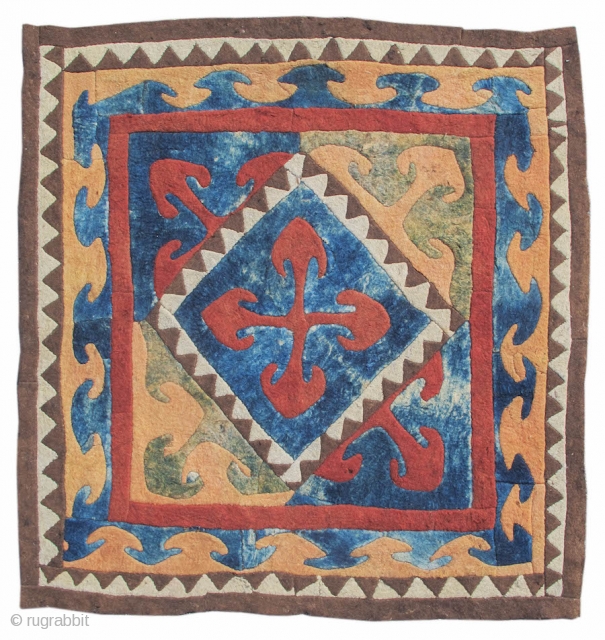19th c (2nd half) Central Asia
5'6"x5'5"
INV#10303
Felt working has a special place among the domestic arts of the nomads of Eurasia. Produced more easily than woven textiles and with incredible insulating properties, felt was vital for the construction of yurts and life on the harsh steppe. In the Kyrgyz tradition, felt pieces composed of sewn and backed reciprocal designs are known as 'shyrdak'. Despite their utilitarian function, nomadic craftswomen imbued their felt pieces with the same care and artistry that defined their material culture. Nonetheless, the lifespan of a shyrdak was relatively short, about 10 to 15 years, and older pieces were frequently recycled for scrap or integrated back into newer production. Hence, older pieces are much more rare than one might expect. This square Central Asian shyrdak makes use of antique vegetable dyes. The reciprocal patterns are both dynamic and fundamental, combining design with complimentary contrasting color. This is a true example of authentic Central Asian tribal textile art.
- Home
- Antique Rugs by Region
- Category
- Profiles
- Post Items Free
- Albums
- Benaki Museum of Islamic Art
- Budapest: Ottoman Carpets
- Gulbenkian Museum
- Islamic Carpets. Brooklyn
- Islamic Textiles. Brooklyn
- Konya Museum: Rugs
- MKG, Hamburg
- MMA: Caucasian Carpets
- MMA: Mamluk Carpets
- MMA: Mughal Indian Carpets
- MMA: Ottoman Carpets
- MMA: Safavid Persian Carpets
- MMA: Turkmen Rugs
- McCoy Jones Kilims
- Ottoman textiles. Met
- Philadelphia Museum
- Rugs and Carpets: Berlin
- Seljuqs at the Met
- TIEM, Istanbul: Carpets
- V&A: Classical Carpets
- Vakiflar Carpets: Istanbul
- Baluch Rugs: Indianapolis
- Gallery Exhibitions
- Jaf an Exhibition
- Alberto Levi Gallery
- Andean Textile
- Christie's London: 2016
- Francesca Galloway
- HALI at 40
- ICOC Washington, DC 2018
- Jajims of the Shahsavan
- London Islamic Week April, 2018
- Mongolian Felts
- Navajo Rugs: JB Moore
- Persian Piled Weavings
- SF Tribal & Textile Art Show 2020
- SF Tribal 2019
- Sotheby's: C. Alexander
- Turkish Prayer Rugs
- Turkmen Main Carpets ICOC 2007







